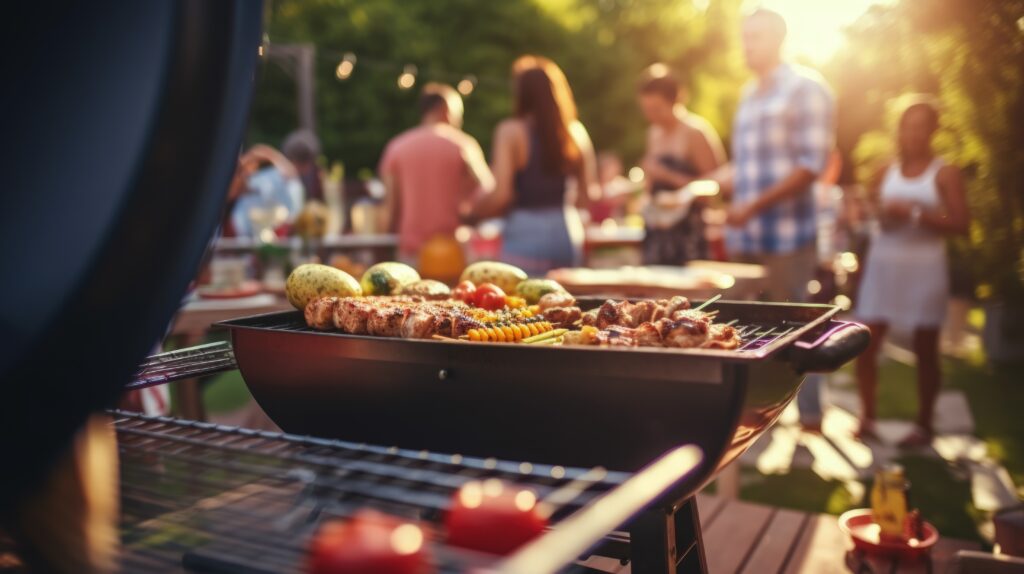
Planning a backyard BBQ? Fabulous! But now you learn that food allergies are coming to your party too. One of your guests has celiac disease and another’s child is allergic to peanuts. What to do? There’s no need to panic (or retract invitations)! With a little planning and careful food handling, you can pull off a perfect, allergy-friendly summer BBQ. Here are our top tips:
Be a Considerate Host
You want your guests to enjoy your backyard BBQ, so you take care to make sure everything is “just right.” This includes ensuring that the food is not only delicious, but also safe for them. Here are a few things you can do as you put together your invite list:
- Whether your invitation is verbal, texted, emailed, or a fancy printed one, always ask about any food allergies. A simple “Do you have any food allergies or intolerances we should know about?” will do. This is especially important if kids are coming since children have a higher rate of food allergies than adults.
- Follow up to ask which specific foods and ingredients your guest needs to avoid. Then make a list of them—you’ll need that information later when planning the menu.
- Don’t worry that you’re being nosy or overly concerned. People with food allergies will appreciate your thoughtfulness and don’t mind being asked about these details prior to an event.
Potluck Pointers
Potluck BBQs are popular for a few reasons. They are usually easier on the host’s budget. They spread the cooking work around. And it’s fun for folks to show off their culinary skills if they like. Sharing is caring! Here are a few tips to make the potluck planning go more smoothly:
- Assuming you already know that a food-allergic guest is coming, it’s your job to let all other invitees know. Be specific about which foods and ingredients are off-limits.
- Potlucks that aren’t planned well typically end up with a very unbalanced selection of food. (Picture a table full of burgers, desserts, and chips, with nary a veggie in sight.) To avoid this, assign specific dishes to guests, such as green salad, pasta salad, fruit platter, pasta side dish, etc. Within those categories, people can flex their culinary muscles while still being careful about the food allergens.
- It also makes sense to ask your food-allergic guests what they would like to bring to your BBQ. Then they will know they are safe eating at least the food that they prepared.
- As guests arrive, confirm that none of their dishes have the offending food allergens or no-go ingredients. It might seem like a hassle, but details matter when it comes to food allergies. And it’s certainly better to be sure up front than sorry later.
- Finally, put placecards or stick-on labels on food containers as they come in. Include the name of the dish and the presence or absence of any problematic ingredients, such as “Brownies–no nuts” or “Potato salad with egg.”
Have a Well-Planned Menu
People often eat more at a casual party like a backyard BBQ than they would at a regular meal. So it pays to give thought to the menu and amount of food you’ll need to feed your gang.
- Something to nosh on when guests first arrive is handy—especially if it’s a serve-yourself situation. For that, you’ll need allergy-friendly snacks that everyone can enjoy.
- If it’s an early day BBQ, people probably won’t have had a full meal yet. Plan on two entrée servings per adult—having a few choices is considerate (an animal-free protein option is nice too).
- Be careful with marinades, sauces, or seasoning mixtures that you’ll be using with your grilled items. They often contain wheat, soy, sesame, or other allergens.
- Always read the ingredient statement on the food label of every ingredient you are using in every recipe.
- Use the Guiding Stars Food Finder tool to see food labels, including ingredient statements and Guiding Stars ratings. It even lets you filter results by specific food allergens. This is such a handy way to search for food ingredients that meet your needs when planning an allergy-free menu.
- Aim to have at least two side dishes that include vegetables to give balance to the meal. Be extra careful with common BBQ side dishes like potato salad, pasta salad, and macaroni salad. They could all include some of the major food allergens, and the same goes for dips, spreads, or appetizers.
Practice Safe Food Handling and Serving
Planning the food and carefully selecting ingredients are key to hosting an allergy-friendly cookout or BBQ. But mistakes can still be made in cooking, handling, and serving those foods. Follow these tips to keep all your food safe for everyone to eat:
- Handle foods safely to minimize the chance of foodborne illness, and wash your hands well before preparing food. Other FDA food safety tips can be found here.
- Preventing cross-contact (sometimes called cross-contamination) between foods that contain a food allergen and those that don’t can be tricky. Be aware that crumbs and juices can be hard to control and are a source of cross-contamination. Serving platters, cutting boards, toasters, and even spoons and knives can transfer allergens from one food to another. This is why keeping food allergens out of the kitchen as much as possible is so helpful. When that’s not possible, it’s essential to have a dedicated space to prepare the “safe” food, along with specific prep tools and serving items.
- Label all foods, noting whether they include an allergen or not (“nut-free,” “dairy-free,” etc.).
- If necessary, cook the allergen-free meal first, then keep it covered and away from any splatter.
- It always pays to keep general food safety in mind, especially for outdoor events. Always follow FDA recommendations for safe cooking and chilling temperatures. And in general, keep hot foods hot and cold foods cold.